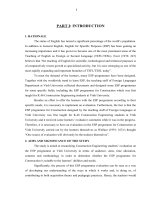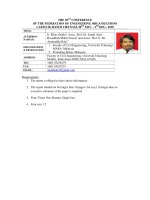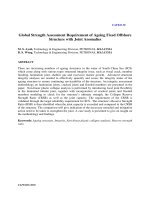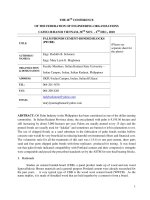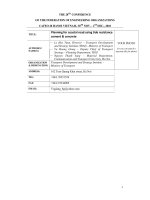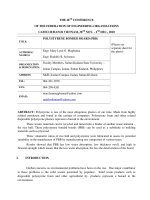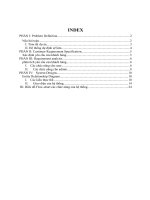Homework - Requirement engineering
Bạn đang xem bản rút gọn của tài liệu. Xem và tải ngay bản đầy đủ của tài liệu tại đây (114.87 KB, 9 trang )
HOME WORK
REQUIREMENT ENGINEERING
Name: Le Van Hao
Class: K15CMUTPM
I. Introduction:
Documentation was conducted to present an overview about the library
system of the QuangNam University of Pedagogical and the mode of
operation is happening and the problems is happening in order to make a
new plan to improve the system.
Project Name: upgrade and development of university library systems to
borrowing books.
Proposed systems: apply technology to the library system to increase
effectiveness in managing loan books, return books and to integrate
website in the system.
II. Referenced:
The system documentation for new users of software.
For questions or encounter errors that users can also refer to the
instructions online through the hotline.
III. Current system and situation:
1. Background, Objectives, and Scope:
a. Background:
Nowaday the most libraries are return and borrowed books like a
manual type , that's mean if you want to read and borrow book ,
you would talked with the librarian.
Nowaday , application of technology to serve readers new project
to upgrade the system, reduction in employment and improve
service quality.
b. Objectives:
The system allows managers can update information entered all of
these books have you read in the libraries to be searchable in a
convenient, but also integrates Web browser, allowing users to
place and loans borrow books in the library online.
The system has divided section dedicated to a manager and you are
reading. You can only read the search and asked to borrow library
books or place, managers are allowed to change add a library book
information.
During use the user may require software developers to complete
more of the functionality available in the system.
c. Scope:
Library system at the DuyTan University.
2. Operational policies and constraints:
a. Policies:
Reader must register membership to borrowing books.
When readers borrow or return books must show their membership
card.
b. Constraints:
Return and borrowed books like a manual type.
Readers can not borrow or return books after hours.
3. Description of current system or situation:
a.
Situation:
•
Add new books for libraries:
Periodically, the library will buy new books or books were donated
by other agencies or organizations you are the technique of the
library will have recorded information about this book in the library
profession in the book window.
Librarians book search or director - parts library management,
readers looking for information about a book that must find the
item in stock. Because holdings are designed according to each
subject category: Economy, Society, Politics, Engineering, etc ...
However, finding a book to determine which books are in stock or
not, or has been borrowed and usually takes long time.
•
Library Card:
Readers including students and faculty members - the school staff.
Every reader wants to borrow books in libraries are required to
borrow library cards. When making a library card, readers must pay
to the accounting department (called the bond and will be refunded
upon graduation from school) and bring receipts to the public
library with a picture card to card. The librarian will schedule a few
days after taking the card back. And meanwhile, readers can use the
card to pay to borrow books.
•
Borrow books:
Readers to the library to borrow books to meet the librarian. When
you borrow books, readers must bring your library card and loan
program for librarians, library records of books borrowed
information on borrowing shares and then sandwiched with
borrower card readers and retained. Each reader borrow maximum
of 3 books or 5 books a few years depending on the students.
•
Return Policy:
Bring readers to return book, the librarian will get to vote on loan a
borrower card for comparison. If readers have paid off the loan
book, the new loan to pay them back. If readers do not pay out
policy, but they can borrow more if not penalized by paying
overdue books.
•
Statistics:
Statistics and statistics regularly recurring.
Each day, the library director would like to borrow books with
number of how many, what type is the most lent.
Annually, the library will conduct the inventory to check how many
are left books, have been lost or misplaced. Inventory to work
normally done by hand by writing a book on how many a book, and
books that were lost.
b. Requirement current system:
Due to a growing audience, the need to borrow is also increased
with the introduction of IT application in management has
increased the efficiency of the work, information on books to be
digitized to facilitate finding easier.
Construction management software libraries QuangNam University
of Pedagogical met some of the following requirements:
Digitization of all the information about books, textbooks,
materials.
Information on loan payment readers are digitized, creating
conditions favorable for statistics.
Readers can search information easily through the books of the
library website.
Assist in the library inventory a simple and clear.
c. The operational environment and its characteristics
Good material facilities good , computer system connection with an
internet
Human resources are firmly professionals and capable of working
in high pressure environment.
Procedures for operating the system: the library staff must have an
account of system to intervene and perform tasks on the computer
system such as borrowing books, renewing books, locking
account…
Readers work with library staff to borrow books and return books.
d. Major system components and the interconnection among those
components:
There are three computer tasks is managing the library. Computers
with internet connection, sever all links with the University of
DuyTan to back up data and information security. Associated with
the library's website to inform the latest information of the library
such as the number of books borrowed, number of new books.
e. Interfaces to external systems or procedures:
When you want to borrow books or renew existing policies, users
need to register your membership card, borrow books, renew books
and pay policies need to present student ID.
f. Capabilities, functions, and features of the current system, including
types of transactions processed:
Ability of system functions: allows borrow books, renew, the return
policy, manager the library membership card.
IV. Justification and description of changes:
Because the system library don’t apply technology to the library
system to increase effectiveness in managing loan books, return
books and to integrate website in the system. So the software
system will hepl in job manage library become simpler and more
efficient.
1. Justification of changes:
The system sofware will digitization of all the information about
books, textbooks, materials.
Simultaneously the system software will provide manager the
ability manage all information of the book in library, and all reader
have been borrowed library the books.
2. Description of disired changes
The system software will provide the user such software based on
their business processes to increase work efficiency and save time
and manpower.
Capability changes:
System software will be compeleted in six months.
System processing changes:
From model to handle manually processed by computer.
Interface changes:
From paper processing to handle the computer screen.
Personnel changes:
Only a few managers are able to manage the entire library system.
3. Priorities among changes
High priority:
Capability changes, system processing changes, personnel
changes, environment changes, operational changes.
Normal priority:
Support changes, interface changes, others changes…
4. Changes Considered But Not Included:
Comments and rating below book.
News about book.
Background: library System is identified as a combination
system. Combination systems have independent member
libraries and also offer direct services to the public users.
Objectives:
• Library Staff and Student.
Scope:



